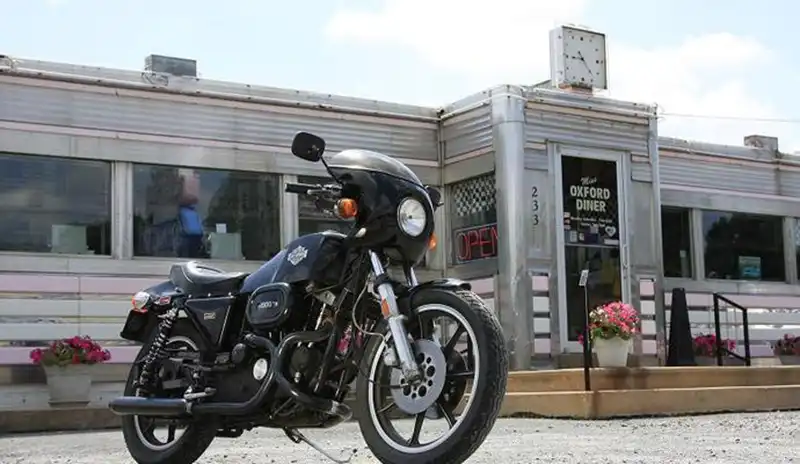 The mid-seventies were the doldrums for The Harley-Davidson Motor Company. AMF, the giant recreational-products corporate conglomerate, was calling the shots and, while sales had actually increased, quality control, reputation and profitability suffered. Willy G. Davidson, a descendent of the original H-D founders, was a young design engineer with an eye for aesthetics. AMF was willing to try new ideas, and Willy had more than a few.
The mid-seventies were the doldrums for The Harley-Davidson Motor Company. AMF, the giant recreational-products corporate conglomerate, was calling the shots and, while sales had actually increased, quality control, reputation and profitability suffered. Willy G. Davidson, a descendent of the original H-D founders, was a young design engineer with an eye for aesthetics. AMF was willing to try new ideas, and Willy had more than a few.
The café racer craze was huge in Europe, and looked poised for growth here. Traditional Harley riders were definitely not café types, but the thinking was that a radical café racer from H-D might bring new customers into the fold. With a frame derived from dirt track machines, a mildly breathed-on motor, disc brakes and a bikini fairing, the new black-on-black XLCR excited the magazine testers way more than paying customers. Evidently, it was too Harley for the café set, and too café for the Harley set – firmly in control of a non-existent market segment. Being somewhat non-conformist I lusted for one, but was unable to accumulate enough money (it was a Harley, after all) before the short two-year production run ground to a halt.
Nearly twenty-five years later, I actually had the financial resources in place, but XLCR’s had become ‘collectable’. A concerted internet search finally turned one up in Ohio, and after consummating the sight-unseen sale via the internet, I bought a one-way airline ticket to Dayton. The seller showed me the ins and outs, produced the original bill of sale and extensive service records, took my money and asked: “Where’s your truck?” When I told him I intended to drive the bike home to Pennsylvania, he exclaimed “Your genitals will never survive the journey!”
I enjoy a challenge as much as anyone, but there is a limit. Turns out he was referring, justifiably, to a serious conflict between the seat pad and the rear fuel tank mount. The oversized mount intruded upon the under-padded seat at the worst possible anatomical location, especially when the rear-set footrests and flat handlebars were considered. Fortunately, I found that my heavy winter gloves could serve as supplemental padding, and I made it home with all parts intact.
Reworking the seat/rear fuel tank mount was easy. During routine shakedown, I also upgraded the rear shocks to Works Performance units, added modern lights, tires, brakes and drive chain, rebuilt the top end and front forks and had the exhaust system ceramic coated. Even with the slightly-weathered original paint, this bike turns heads. And the ride? Well, it’s like no other, a fitting tribute to Willy Davidson that combines the primitive thumping-thrusting-locomotive Harley Iron Head characteristic with the feet back, low-bar café experience. Make no mistake, this is a café racer, but the ride is all about The Motor, which clearly dominates as it emits its potato-potato roar.
Two 500 cc pistons not quite working together produce manly torque with little concession to creature comfort. You feel this one. The footrests and the controls, the handlebars and the grips, are all oversized. This bike is a 1,000 pound gorilla; best be nice to it. On the other hand, leaving it in 4th gear and rolling on smoothly as you bend through turns keeps you surfing on a BIG wave of torque, rewarding your finesse with one satisfying lunge after another as The Motor chews up the asphalt. It is, above all, a visceral experience. One mile is too much, but 100 miles is not enough.

